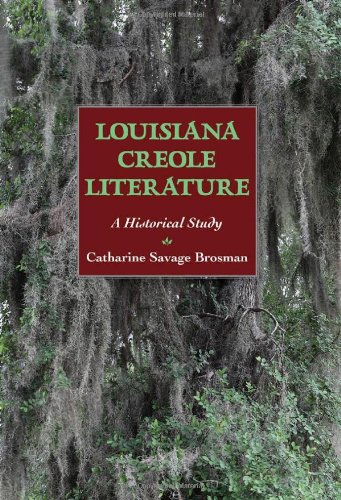Louisiana Creole Literature: A Historical StudyPosted in Biography, Books, Literary/Artistic Criticism, Louisiana, Media Archive, Monographs, United States on 2013-12-05 20:01Z by Steven |
Louisiana Creole Literature: A Historical Study
University Press of Mississippi
2013-10-17
256 pages
6 x 9 inches, bibliography, index
Hardback ISBN: 9781617039102
Catharine Savage Brosman, Professor Emerita of French
Tulane University, New Orleans, Louisiana
Louisiana Creole Literature is a broad-ranging critical reading of belles lettres—in both French and English—connected to and generally produced by the distinctive Louisiana Creole peoples, chiefly in the southeastern part of the state. The book covers primarily the nineteenth and twentieth centuries, the flourishing period during which the term Creole had broad and contested cultural reference in Louisiana.
The study consists in part of literary history and biography. When available and appropriate, each discussion–arranged chronologically–provides pertinent personal information on authors, as well as publishing facts. Readers will find also summaries and evaluation of key texts, some virtually unknown, others of difficult access. Brosman illuminates the biographies and works of Kate Chopin, Lafcadio Hearn, George Washington Cable, Grace King, and Adolphe Duhart, among others. In addition, she challenges views that appear to be skewed regarding canon formation. The book places emphasis on poetry and fiction, reaching from early nineteenth-century writing through the twentieth century to selected works by poets still writing in the early twenty-first century. A few plays are treated also, especially by Victor Séjour. Louisiana Creole Literature examines at length the writings of important Francophone figures, and certain Anglophone novelists likewise receive extended treatment. Since much of nineteenth-century Louisiana literature was transnational, the book considers Creole-based works which appeared in Paris as well as those published locally.
Catharine Savage Brosman, Houston, Texas, is professor emerita of French at Tulane University. She is the author of numerous books of French literary history and criticism, two volumes of nonfiction prose, and nine collections of poetry.
Contents
- Preface
- Chapter One. Louisiana and Its Population: The Historical Background
- Chapter Two. Features of Early Louisiana Literature and the Cultural Milieu
- Chapter Three. Pere Rouquette and Other Early Francophone Poets
- Chapter Four. Mercier and Other Novelists Born in the Early Nineteenth Century
- Chapter Five. Mid-Nineteenth-Century Immigrant Francophone Authors
- Chapter Six. Fiction and Drama by Mid-Nineteenth-Century Free People of Color
- Chapter Seven. Poetry by Mid-Nineteenth-Century Free People of Color
- Chapter Eight. Cable and Hearn
- Chapter Nine. Late Francophone Figures: de la Houssaye, du Quesnay, Dessommes
- Chapter Ten. Kate Chopin
- Chapter Eleven. King, Stuart, and Others
- Chapter Twelve. Some Twentieth-Century Louisiana Prose Writers
- Chapter Thirteen. Louisiana Creole Poets of the Twentieth and Twenty-First Centuries
- Notes
- Selected Bibliography
- Index


